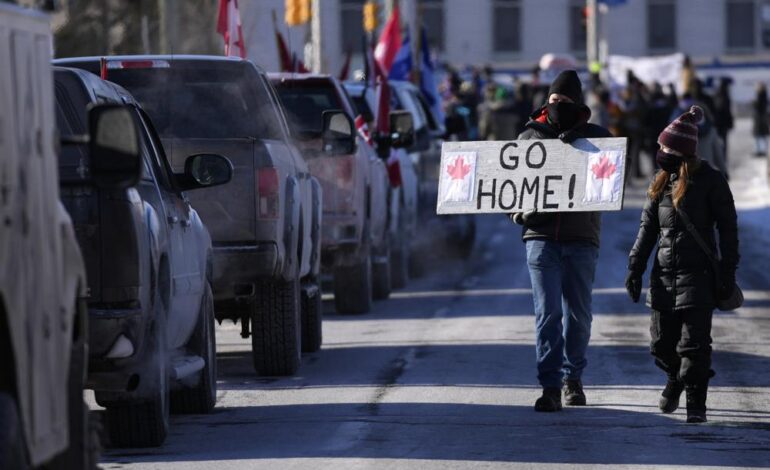WINDSOR — The busiest U.S.-Canada border crossing was open Monday after protesters demonstrating against COVID-19 measures blocked it for nearly a week, but a larger protest in the capital, Ottawa, persisted as city residents seethed over authorities’ inability to reclaim the streets.
Demonstrations against virus restrictions and other issues have bottled up several crossings along the U.S.-Canada border and hurt the economies of both nations. They also inspired similar convoys in France, New Zealand and the Netherlands. U.S. authorities have said that truck convoys may be in the works in the United States.
Police in Windsor, Ontario, arrested 25 to 30 protesters and towed several vehicles Sunday near the Ambassador Bridge, which links Windsor — and numerous Canadian auto plants — with Detroit. The bridge, which carries 25 percent of all trade between the two countries, reopened to traffic late Sunday night.
After protesters began blocking bridge access Feb. 7, automakers began shutting down or reducing production at a time when the industry is already struggling with pandemic-induced shortages of computer chips and other supply-chain disruptions.
“Today our national economic crisis at the Ambassador Bridge came to an end,” Windsor Mayor Drew Dilkens said on Sunday.
About 470 miles northeast of Windsor, the protest in Ottawa has paralyzed downtown, infuriated residents who are fed up with police inaction and turned up pressure on Prime Minister Justin Trudeau.
Trudeau planned to meet virtually with the leaders of Canada’s provinces on Monday morning, as well as with lawmakers.
The city had appeared to have reached a deal in which protesters, who have jammed downtown streets for more than two weeks, would move out of residential areas, but those prospects soon faded.
Mayor Jim Watson said Sunday that he agreed to meet with demonstrators if they confined their protest to an area around Parliament Hill and moved their trucks and other vehicles out of residential neighborhoods by noon Monday. He shared a letter from one of the protest’s organizers, Tamara Lich, in which she said demonstrators “agree with your request” to focus activities at Parliament Hill.
But Lich later denied there was an agreement, saying in a tweet, “No deal has been made. End the mandates, end the passports. That is why we are here.”
In a letter Watson wrote to protesters, he said residents are “exhausted” and “on edge” because of the demonstrations and he warned that some businesses are on the brink of permanent closure.
In Surrey, British Columbia, police arrested four demonstrators Sunday, and officers in Alberta said they intercepted and disabled three excavators that were being brought to a border blockade in the town of Coutts.
While the protesters are decrying vaccine mandates for truckers and other COVID-19 restrictions, many of Canada’s public health measures, such as mask rules and vaccine passports for getting into restaurants and theaters, are already falling away as the omicron surge levels off.
Pandemic restrictions have been far stricter in Canada than in the U.S., but Canadians have largely supported them. The vast majority of Canadians are vaccinated, and the COVID-19 death rate is one-third that of the U.S..
On Friday, a judge ordered an end to the blockade at the Ambassador Bridge and Ontario Premier Doug Ford declared a state of emergency allowing for fines of $100,000 Canadian and up to a year in jail for anyone blocking roads, bridges and other critical infrastructure.
Michigan Governor Whitmer welcomed the end the blockade as “a win for Michigan’s working families who are just trying to do their jobs and for businesses who can get back to shipping their products and produce.” She added, “It’s important to ensure that this does not happen again.”
Michigan officials estimate that 10,000 commercial vehicles cross the bridge each day with $325 million of goods, approximately $50 million from automotive parts.
The Windsor protest began to dwindle Saturday after police persuaded many protesters to remove vehicles blocking the road to the bridge. But in Ottawa, Saturday’s crowd swelled to what police said were 4,000 demonstrators and a counter-protest of frustrated Ottawa residents attempting to block the convoy of trucks from entering downtown emerged Sunday.
Clayton Goodwin, a 45-year-old military veteran who was among the counter-protesters, said it was time for residents to stand up against the protesters.
“I’m horrified that other veterans would be down there co-opting my flag, co-opting my service,” said Goodwin, CEO of the Veterans Accountability Commission, a nonprofit advocacy group. “It’s a grift. The city was free. We’re 92 percent vaccinated. We’re ready to support our businesses.”
Colleen Sinclair, another counter-protester, said the demonstrators have had their say and need to move on — with police force, if necessary.
“They’re occupiers,” she said. “This is domestic terrorism and we want you out of our city. Go home.”
Trudeau has so far rejected calls to use the military, but has said “all options are on the table” to end the protests. He has called the protesters a “fringe” of Canadian society. Both federal and provincial politicians have said they can’t order police what to do.
— Associated Press News report, edited for style






Leave a Reply